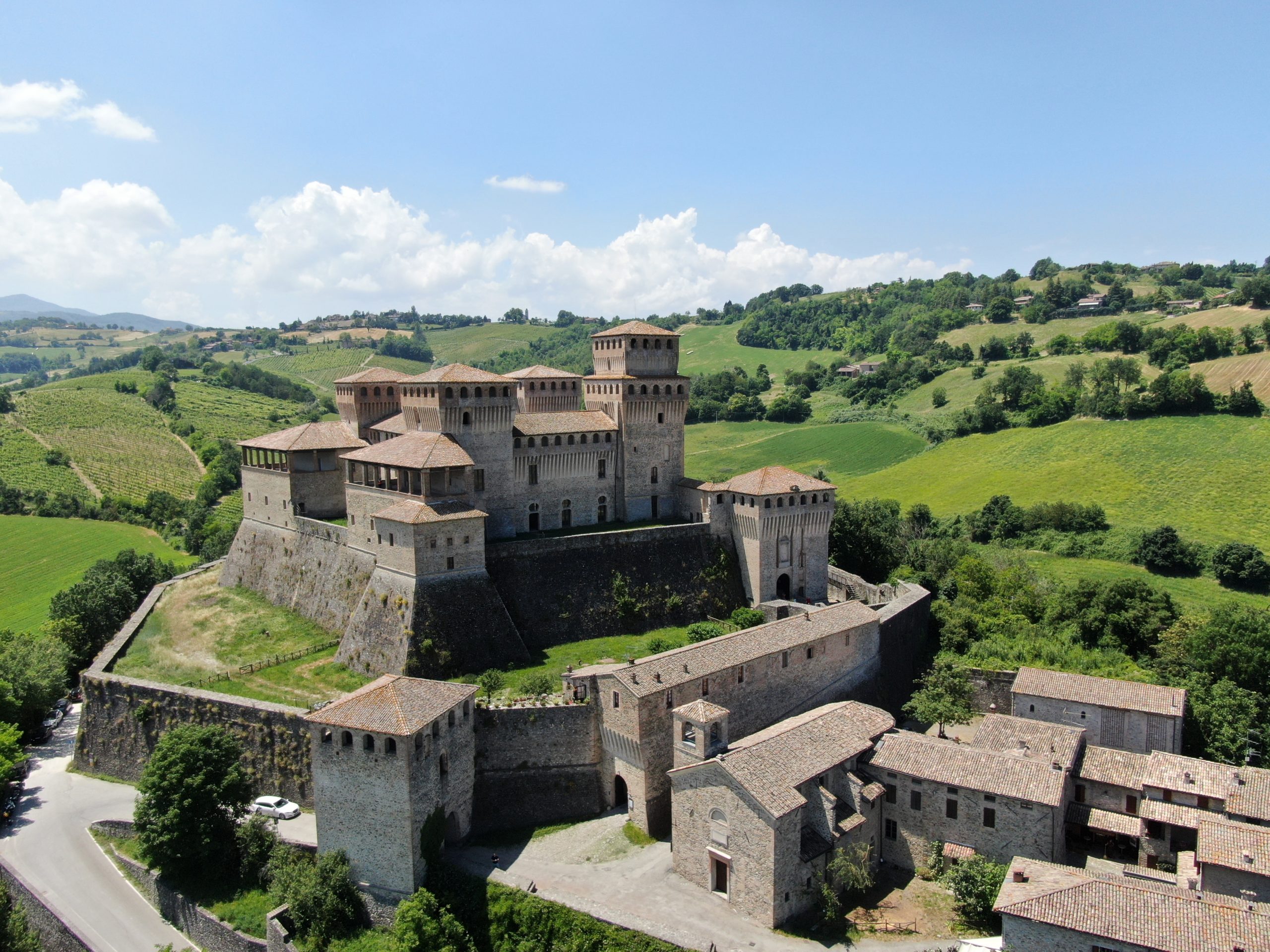
Torrechiara Castle is a 15th-century castle near Langhirano, in the province of Parma, northern Italy. It sits atop a terraced hill south of the city of Parma, in a strategic position overlooking the Parma (river) in the valley below. The interior features numerous rooms decorated with fantastic, grotesque or naturalistic elements. On the first floor, together with the Salone dei Giocolieri (“Jugglers Hall”), is the Camera d’Oro (“Golden Bedchamber”), one of the most famous examples of bedchamber artistic decoration in Italy. The fresco cycle in the lunettes portrays Bianca Pellegrini running through her and Rossi’s lands, searching for her lover: the paintings are attributed to Benedetto Bembo. The chamber opens onto a panoramic loggiato.
A Glimpse into Renaissance Splendor
Nestled in the rolling hills of the Parma countryside in Italy, Torrechiara Castle stands as a majestic reminder of the country’s rich historical and artistic heritage. Recently, this iconic 15th-century fortress has garnered renewed attention due to the discovery of breathtaking frescoes that shed new light on the artistic grandeur of the Renaissance period.
A Historical Gem
Torrechiara Castle, built between 1448 and 1460 by Pier Maria Rossi, a nobleman of the powerful Rossi family, was intended as both a defensive stronghold and a romantic retreat. The castle’s design is a harmonious blend of medieval military architecture and the refined elegance of the early Renaissance. Its strategic location, overlooking the fertile plains and lush vineyards of the Parma Valley, only adds to its allure.
For centuries, Torrechiara Castle has been celebrated for its architectural beauty, particularly the famous “Golden Chamber” (Camera d’Oro), which features intricate gold-leafed frescoes depicting scenes from the lives of Pier Maria Rossi and his beloved, Bianca Pellegrini. However, recent restorations have unveiled a hidden treasure trove of frescoes that had remained obscured for centuries.
The Unveiling of Hidden Frescoes
The restoration project, initiated in 2022, was aimed at preserving the existing artworks and ensuring the structural integrity of the castle. During this meticulous process, conservators were astonished to discover a series of frescoes concealed beneath layers of plaster and grime. These newly revealed artworks are believed to date back to the late 15th century, a period when Torrechiara Castle was at the height of its cultural and political influence.
The frescoes, which adorn several rooms within the castle, depict a wide array of themes, from religious iconography to intricate mythological scenes. One of the most striking discoveries is a series of frescoes in a previously inaccessible chamber, which illustrate the myth of Cupid and Psyche. The vivid colors and delicate brushwork of these paintings have been remarkably well-preserved, offering a rare glimpse into the artistic techniques of the time.
The Artistic Significance
The discovery of these frescoes has been hailed as a significant contribution to the study of Renaissance art. Experts believe that the frescoes were likely commissioned by Pier Maria Rossi himself, who was known for his patronage of the arts. The style and composition of the frescoes suggest the influence of prominent artists of the period, though the exact identity of the painters remains a subject of ongoing research.
What sets these frescoes apart is their unique blend of Gothic and Renaissance elements. The intricate detailing, the use of vibrant colors, and the incorporation of both religious and secular motifs reflect the transitional nature of the period. The frescoes also provide valuable insights into the cultural and social milieu of the time, illustrating the themes and stories that resonated with the nobility of the Renaissance era.
A Cultural Treasure
The unveiling of these frescoes has not only enriched the artistic heritage of Torrechiara Castle but has also sparked renewed interest in its preservation. The castle, already a popular tourist destination, is expected to attract even more visitors eager to witness these newly discovered masterpieces. The frescoes are now being carefully restored and preserved, ensuring that future generations can continue to marvel at their beauty.
In addition to their artistic value, the frescoes have also contributed to a deeper understanding of the historical significance of Torrechiara Castle. They serve as a testament to the cultural sophistication of the Renaissance and the enduring legacy of the Rossi family, who played a pivotal role in shaping the artistic landscape of the region.
Conclusion
The revelation of the hidden frescoes at Torrechiara Castle is a reminder of the countless treasures that lie beneath the surface of history, waiting to be uncovered. As these exquisite works of art are brought back to life, they offer us a window into the past, allowing us to connect with the people and stories of a bygone era. Torrechiara Castle, with its newly discovered frescoes, continues to be a beacon of Italy’s rich cultural heritage, a place where history, art, and romance converge in a timeless embrace.
